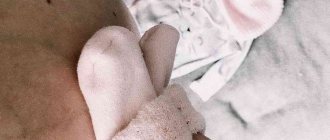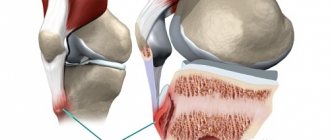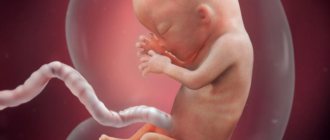Pregnancy is a time when a woman listens to the slightest changes in her body.
Knowing that pain, including in the perineal area, is a beacon signaling problems, at the first sign of discomfort the expectant mother begins to worry. There is no need for her to worry in vain, and therefore if discomfort arises, it is better to consult a specialist for advice. Pain in the perineum during pregnancy can even be caused by natural causes - in this case you will simply have to endure it. Most often they appear in late gestational stages and are harbingers of imminent labor. But they can also be caused by pathological reasons, which means treatment is required. Therefore, let’s look at the reasons for this phenomenon in more detail.
Any inflammatory processes occurring in the pelvic organs can cause a woman to feel unwell.
Anatomy of pregnant women
Pregnancy is truly the most joyful and bright moment in a woman’s life.
Naturally, because the birth of a new life takes place in it. Nine long months of gestation sometimes bring not only positive emotions, but also painful sensations. This is due to multiple changes in the body, which is adjusting to a new regime and adapting to new working conditions. The center of gravity shifts and this can create not only stress, but also cause pain in the back and legs, aching pain also appears in the abdominal area. Pain in the groin during pregnancy sometimes accompanies a pregnant woman constantly, which can be either a natural symptom or evidence of some pathology. Very often, under such circumstances, gynecologists make a diagnosis of “divergence of the pubic symphysis,” which consists of many elastic ligaments. In order for a child to normally cross the birth canal during childbirth, the ligaments must be relaxed, which is why in the third trimester of pregnancy the female body begins to produce a certain hormone responsible for the mobility of the ligaments. A side effect of its work is precisely the condition when the groin hurts during pregnancy. This can only be accurately diagnosed using ultrasound, so if pain occurs, you should immediately consult a doctor. A specialist will accurately determine the true cause of the ailment, since the occurrence of such pain is sometimes provoked by a variety of circumstances.
Varicose veins
The causes of perineal pain during pregnancy often lie in varicose veins. Unfortunately, statistics show that almost 25% of women suffer from the appearance of varicose veins after childbirth. Subsequent pregnancies only increase this percentage.
The second half of pregnancy itself is the main cause of varicose veins. The vessels of the lower extremities have to experience a colossal load, which forces the vessels to wear out. The natural blood flow in the legs is hampered by the enlarged uterus, which puts strong pressure on the leading veins of the pelvis . Plus, the volume of circulating blood increases, since full functioning needs to be ensured by not one, but two organisms. Consequently, vascular blood flow is hampered, which becomes the cause of perineal pain during pregnancy.
Signs of illness
At the initial stage of development of the disease, symptoms do not appear at all or make themselves felt with minor signs.
After some period of time, the woman begins to feel:
- Perineal pain in the second half of pregnancy;
- Fatigue after walking;
- Heaviness and itching in the leg muscles;
- Cramps that can occur at any time of the day.
Varicose veins are a dangerous disease that occurs not only on the legs, but also on other parts of the body. Therefore, experts recommend that when the first symptoms appear, you should go to a hospital to avoid possible complications.
Treatment options
Pain in the perineal area during pregnancy caused by varicose veins can be eliminated with the help of therapeutic exercises and traditional medicine. The latest methods should be discussed with your doctor, as some may not be suitable due to the individual structure of each organism.
During pregnancy, the bones between the legs in the groin hurt - treatment
Recommendations and therapy depend on the causes of pain. If the problem is provoked by pathological processes, the treatment regimen is prescribed by the doctor depending on the specific situation and diagnosis.
If the underlying pain is physiological, the expectant mother is recommended to:
If you have problems with neuralgia (pinched nerve), the following will help you feel better:
- Cold and warm compresses.
- Safe gels and ointments. The drugs have a local effect, so the penetration of their components into the blood is minimized.
- Warm salt baths have a good relaxing effect.
- Bandage.
- Massage and manual techniques - strictly with the approval of the gynecologist!
- Physical therapy to help relax the lower back muscles and reduce pain.
In case of pain due to discrepancy of the pubic cartilage - symphysis - a woman will be helped by:
- Wearing a bandage.
- Do exercises recommended by your doctor to strengthen and maintain your muscles.
- Physiotherapy.
- In extreme cases, painkillers are prescribed.
If the cause of pain is a lack of calcium, the pregnant woman is prescribed a course of this mineral. Therapy is completed before 32 weeks of gestation. If you are planning a cesarean section, you can take calcium supplements until the 37th week of expecting a baby.
Regardless of the causes of pain, treatment or maintenance therapy is prescribed only by a doctor!
How to get rid of pain or reduce it?
It is possible to relieve physiological unpleasant sensations and reduce their severity using the following methods:
- Light self-massage of the damaged ligament.
- Local warmth - cover yourself with a blanket and wear warm trousers.
- Warm (not hot) shower.
Regular physical exercise for pregnant women will help prevent the occurrence of pain - they will make the ligaments more elastic, strengthen the muscular frame, so they will be able to bear the load more easily. Wearing a bandage has a good effect, allowing you to more or less evenly distribute the load. In severe cases, the doctor prescribes physical therapy.
Therapeutic gymnastics in the first months of pregnancy
Physiotherapy exercises in the 1st trimester are aimed at normalizing metabolism and blood circulation in the pelvis and perineal muscles, and preventing the appearance of venous stagnation. Strengthens the muscles and bones in the lower back and prevents pain in the muscles between the legs. The exercises are done every day; if discomfort occurs, you should stop and consult a gynecologist.
Remember, if there is a threat of miscarriage and the doctor’s contraindications, if the muscles between the legs hurt, you should refuse to perform physical therapy. In the first trimester, deep squats and heavy lifting are contraindicated. The duration of the exercises is initially up to 15 minutes.
Breathing exercises for a pregnant woman
Exercises recommended in the first trimester:
- Physical education begins with breathing exercises. Inhale for 2 seconds, exhale for 3-5 seconds. Pause between exhalation and inhalation 1-2 seconds.
- Strengthening exercises for the muscles of the perineum and lower extremities.
- Standing position. You need to lean on the chair and back, fingers relaxed. From the initial position, do shallow squats; the muscles in the lower back should not be strained too much;
- The exercise is performed standing, leaning on the back of a chair. The leg crosses forward, sideways and backwards. Afterwards the exercise is performed with the other leg;
- The exercise is performed standing, feet shoulder-width apart, fingers relaxed. Legs bend at the knees, hands rest on hips. Make 10 circular movements in both directions. The muscles in the lower back are strengthened.
Gymnastics will help a pregnant woman reduce pain in the muscles between her legs.
Perineum hurts during pregnancy (second trimester)
The fetus in a woman’s body increases significantly in size in the second trimester. This
may cause a woman to feel slight pain in the pelvic area and pubic area. They may cause discomfort, but are quite tolerable. Normal can be called lumbodynia that does not particularly bother the pregnant woman and does not spread to other organs and areas. You should visit your doctor right away if these sensations are persistent and get worse.
If in the second trimester unpleasant sensations appear not only in the perineum, you also need to pay attention to this. For example, the reason to come for an examination may be pain in the lower back, pelvic bones
Only a specialist who observes a woman will be able to conduct examinations and identify the cause of lumbodynia.
In general, when the perineum hurts during pregnancy, it is important not to give free rein to your emotions and worry too much. You should first determine the cause of such manifestations by visiting your doctor.
Sometimes the reason may lie in the state of the woman’s body, which has nothing to do with bearing a child. She may have chronic diseases such as venous dilatation of the pelvic veins, compression of the sciatic nerve, etc.
All this could manifest itself in the second trimester, when pregnancy became an additional burden for the body. When pain in the perineum during pregnancy does not cause significant discomfort, this is the norm. When carrying a child, many uncomfortable sensations may arise, since the body is also susceptible to changes.
Most likely, the doctor will recommend a course of treatment after childbirth. Lack of calcium and sufficient vitamins can also affect the occurrence of pain in the pelvic bones. There can be quite a few reasons that can only be determined by a specialized specialist.
But it is still important to undergo examinations and tests before the birth of the child.
Fighting methods
It is worth preparing for pregnancy in advance. And not only in terms of giving up bad habits, getting rid of STDs and taking vitamin complexes.
Women leading an active lifestyle and athletes rarely complain of pelvic pain and discomfort in the perineum due to sprained ligaments and impaired blood supply. Their soft tissues are adapted to stress, and stretching does not cause noticeable discomfort. In addition, during the period of gestation, they continue to engage in permitted sports: yoga, swimming, etc. This improves the movement of blood through the vessels and is an excellent prevention of varicose veins and other pathologies associated with compression of organs.
In later stages of gestation, the only effective measure is to wear special maternity belts. They can be prenatal or combined, suitable for use during pregnancy and after childbirth. Such a belt softens external impacts and protects the fetus during mild shocks.
Consumption of dairy and other products containing calcium helps strengthen the ligamentous apparatus. The use of any medications, as well as dietary nutrition, is agreed upon with the obstetrician.
Changing positions and allowing exercises during the appropriate period help improve blood flow and reduce pain. You should not stay in one position for a long time. Sitting a lot is especially harmful.
Why do abdominal muscles hurt during pregnancy?
Since the uterus begins to expand upward and forward during pregnancy, in addition to pressure on the pelvic bones, there is an effect on the abdominal press. Its muscles begin to gradually stretch, “freeing up space” in the abdomen for the fetus with its surrounding membranes. Each girl's abdominal muscles are developed individually, which reflects their ability to stretch.
If they are of sufficient size and good tone, then under the influence of the growing uterus their elastic stretching will be observed.
The effect of pregnancy on the abdominal muscles
The main pregnancy hormone, progesterone, also takes part in preparing muscle tissue (for stretching by the growing uterus). It begins to be released in maximum quantities from 4 weeks after conception, when the placenta is formed. The uniform release of the hormone provides certain effects that are invisible to the expectant mother:
- Progesterone has a good effect on the tone of muscle tissue, which affects literally all organ systems.
- The abdominal press is the main point of application, since the support of the growing uterus during pregnancy will depend on its condition.
- Until the 37th week, the abdominal muscles are in a relaxed state, which freely allows you to increase the internal volume of the abdomen.
- When the final preparations for childbirth are completed, the placenta gradually loses its activity - the level of progesterone in the blood begins to drop sharply.
- After this, the abdominal muscles begin to return to their usual tone and normal activity. The nervous system again takes control of their contractions.
- During childbirth, they take a direct part in contractions, helping the uterus expel the fetus from its cavity.
Therefore, a lot depends on the development of the abdominal muscles before pregnancy - good abdominal muscles immediately ensure a quick and painless birth for a girl.
How to distinguish normality from disease?
Abdominal pain that appears at the end of pregnancy (37–38 weeks) can accompany many complications. But unlike them, sensations when stretching the press arise gradually and are weakly expressed. But symptoms of diseases never occur “typically,” which requires the doctor to be attentive to any complaints. Unpleasant sensations in the abdomen may occur with the following complications:
- Placental abruption, which usually occurs in the later stages - from 37 to 39 weeks. It is also accompanied by moderate aching pain in the abdomen, but it is always accompanied by bloody discharge from the vagina.
- Complete or partial uterine rupture occurs immediately before or during childbirth. It occurs at the height of the contraction and is manifested by sharp pain in the abdomen. After this, the abdomen loses its symmetry - a “recession” area appears.
- Acute and chronic inflammatory diseases are common - they always have a different course. Pregnant women usually experience acute appendicitis or inflammation of the renal pelvis - pyelonephritis. They are also accompanied by aching pain, but against the background of signs of inflammation in the body.
How to reduce discomfort?
Aching pain in the abdominal muscles serves as a kind of preparation for future childbirth, so it should not be eliminated with the help of medications. To reduce discomfort, you can use methods that pose less risk to the baby’s health:
- The main means of prevention is to prepare the abdominal muscles for pregnancy. Its intensive training for a year (minimum) before conception reduces the risk of complications during childbirth.
- If the pain still bothers you, then you should use the choice of the right posture - in certain positions the pressure on the abdomen decreases. You should choose this position yourself, based on your personal feelings. It is not recommended to lie on your stomach or back.
- A relaxing massage helps well - light and smooth stroking of the abdomen has a distracting effect.
Don’t pay too much attention to the symptoms - childbirth is still ahead, during which you will have to endure significant pain
Therefore, the expectant mother needs to be patient when preparing for such an important event, so as not to burden the nervous system
Constipation
The causes of pain in the perineum during pregnancy may lie in constipation, from which many pregnant women suffer. Some people assume that such phenomena are considered normal during pregnancy, but they are deeply mistaken. Constipation can lead not only to perineal pain, but also to more serious disturbances in the functioning of the body.
In the early stages, the causes of constipation can be considered:
- Unbalanced hormonal levels;
- Malnutrition;
- Taking prescribed medications.
In later stages, constipation may occur:
- Reduced physical activity;
- Change in fetal position;
- Disturbed emotional background.
Signs of illness
When a pregnant woman experiences constipation, it is difficult to ignore. Secondary manifestations of the disease include:
- Perineal pain;
- Bloating;
- Discomfort;
- Feeling of fullness in the intestines;
- Sometimes, loss of appetite.
It is strictly not recommended to ignore such a problem as constipation, because they threaten the appearance of:
- Hemorrhoids;
- Ailments of the female organs;
- Toxic poisoning;
- Premature birth;
- Threats of miscarriage.
Treatment options
You can get rid of perineal pain caused by constipation during pregnancy with the help of laxatives, which must be prescribed by the attending physician.
Promotes proper functioning of the body:
- Foods containing a lot of fiber;
- Drinking plenty of fluids;
- Some physical activity.
By adhering to all the necessary recommendations, the woman will forget about the unpleasant sensations and give birth to a healthy child.
Stitching pains
Many pregnant women complain of tingling in the vagina. Doctors name several causes of pain of this nature. Firstly, modifications of the uterus at 5-8 weeks, when its muscles stretch. This phenomenon usually goes away after the specified period. Secondly, they may appear due to excessive gas formation, characteristic of pregnant women. Thirdly, if such pain appears at 37 weeks of pregnancy, then these are most likely signs of imminent labor. In this case, there is no need to worry, since soon the baby will be born and everything will return to normal.
Sometimes pain of this nature, accompanied by discharge, can signal hypertonicity of the uterus. A visit to the doctor in such a situation is mandatory.
If vaginal colitis during pregnancy is mild and short-lived, then there is most likely no reason for concern.
Pain in the perineum during pregnancy
Despite the fact that during pregnancy something often starts to hurt, any pain should still be a cause for concern. Of course, from the first days until the onset of childbirth (and even after them), a woman’s body undergoes enormous changes, which are often accompanied by pain. Therefore, experiencing pain while carrying a baby is, unfortunately, “normal.” However, doctors often say that it’s normal when nothing hurts. How are things really going?
It all depends on what, where and how you hurt. Among the most common complaints of pregnant women is pain in the perineum. They appear mainly from 35-37 weeks and are harbingers of an imminent birth. The baby begins to slowly move forward, putting pressure on the muscles, nerves and ligaments. In addition, the hip joints diverge even more, and the ligaments cannot keep up with them, which causes sharp shooting pains and stretching in the perineum and legs. But such sensations can also occur over a much shorter period of time - in this case, you need to confirm your guesses with a doctor. Often, pain in the perineum in the first weeks may indicate a threat of miscarriage.
In addition to the fact that preparation for childbirth occurs, pain in the perineum can have other causes. Often the fetus puts pressure on nerves (such as the sciatic nerve), causing pain. At the same time, it is not only difficult for a woman to stand up, but also to lie down is very uncomfortable and painful. There is only one way out - to endure it. Perhaps the fetus will take a different position and “release” the pinched nerve.
The cause of pain in the perineum may be loosening of the ligaments, varicose veins of the perineum - this should be determined by a gynecologist and, if necessary, prescribed appropriate treatment.
Usually, pain in the perineum goes away on its own after childbirth. If during delivery there is a rupture of the perineum, this can also cause pain (as well as sutures due to rupture) for some time.
Especially for beremennost.net – Elena Kichak
I have pain between my pubic area and my pubic area, day and night. If I walk for a long time, then I sit down, and after that I get up - it’s with great difficulty - it hurts. Walking can be simply creepy - your eyes pop out of your head. The only thing that saves us is the thought that it will be easier for the little one from all this torment))))))) New December 8, 2008, 15:29
Hi. I have the same problem. It hurts even when I put on my shoes. I also think that it’s the pelvic bones that are moving apart (but maybe it’s also the child pulling out calcium. I read that calcium is taken from here first of all. Although I took enough calcium myself). I do exercises, but maybe 10 minutes before going to work is not enough (we are 26 weeks, still running to work). That’s it. But we will all be great, girls. We are strong and will survive everything. New8 December 2008, 20:09
I have 8 months B. It hurts in the perineum and sacrum and in the leg because of this, but not all the time, but maybe it hurts for a day, but it doesn’t hurt for a day. And the joints became some kind of rubber or plasticine. In a word, it’s not very pleasant. NewDecember 19, 2008, 21:50
Privet.U menya 33 weeks beremenosti u menya eti boli toje, mne skazali chto pri beremenosti et norm. Govryat chto v nachalnie meseci et ot togo chto u nas ves organizm menyaetsya i posledniy pereud beremenosti eti boli bivayut ot togo chto u nas rebenok rastet s kajdim dnem i on davit v niz…
Why does pain occur?
Pain in the perineum in an expectant mother occurs at two stages:
- at the beginning of pregnancy;
- closer to delivery.
Why does the perineum hurt during pregnancy?
Cutting and shooting in the muscles and bones between the legs can be:
- physiological - indicating that the mother’s body is preparing for the birth of a child;
- pathological - indicating the presence of problems or even serious diagnoses.
Pain in the perineal muscles in the early stages, in the first trimester and up to 20 weeks
What does this symptom mean:
- This is how hypertonicity of the uterus or even partial dilatation of the cervix is felt.
This could be a sign of a threatened miscarriage! In this case, you need to urgently consult a doctor. If a sharp pain in the perineum gives way to shooting pain, you should call an ambulance. Such pain usually goes away in the second trimester. - Consequence of exacerbation of venous insufficiency (varicose veins)
. If a woman has already had varicose veins or is prone to varicose veins, she is at risk. Varicose veins in the legs can provoke a similar phenomenon in the pelvic area. This threatens blood stagnation, insufficient blood supply and oxygen supply to the fetus. It may even result in purulent inflammation. - Osteoporosis manifests itself in the form of painful sensations in muscles and bones in the early stages.
The disease is caused and aggravated by calcium deficiency in the expectant mother. - If the symptoms are sharp and severe, you should carefully check your kidneys and urinary system.
Such symptoms occur in pyelonephritis and urethritis (inflammatory diseases of the kidneys and urinary tract).
In the third trimester, at 8 and 9 months
A sure sign of the following:
- At week 35, the fetus is already quite large and puts serious pressure on the walls of the uterus and the perineal area. Because of this, there is pain between the legs, a feeling that the bones hurt. This is especially pronounced when carrying twins or triplets, when the fetus is too large and heavy, when polyhydramnios is diagnosed.
- At week 37, unpleasant sensations, slightly shooting pains at the vaginal exit site, will be caused by the mucous plug coming out.
- At 8 months, the area from the pubis to the anus may hurt because the unborn baby is too active. When a child moves a lot and kicks hard, this often provokes painful symptoms.
- At 37 weeks and beyond, physical inactivity and a sedentary lifestyle can negatively affect the mother’s well-being;
Spine change
Pain in the perineum in pregnant women can be called an integral part of bearing a child. Throughout pregnancy, a woman's skeleton undergoes enormous changes as the spine adapts to the growing fetus.
shutterstock
Painful warning signs may mean that it will soon be time to give birth. The child gradually moves towards the exit, as a result of which all the muscles, organs, and nerves are compressed, the pelvic bones diverge, and the expectant mother feels pain in the perineum.
Signs
Pain is the main symptom that should not be ignored. If there is severe pain in the perineum, it is better to see a doctor. A specialist will determine the true cause.
Other signs include:
- Discomfort;
- Pain when bending over;
- Heaviness in the legs;
- Fast fatiguability.
Treatment options
When pain is a harbinger of imminent labor, the woman will have to endure a little.
If changes in the spine cause excruciating pain, and the due date has not yet arrived, the doctor may prescribe topical gels or ointments. They do not penetrate deep into the blood, do not harm the child, and relieve pain well.
shutterstock
Risk of miscarriage
If your perineum hurts during the early stages of pregnancy, you should immediately see your doctor, as sometimes this may indicate a threat of miscarriage.
© shutterstock
The worst thing that perineal pain can lead to in the first weeks of pregnancy is miscarriage. The disease is a spontaneous abortion.
Experts have been able to identify a number of factors that contribute to miscarriage.:
- Genetic failures;
- Lack of progesterone;
- Rh-conflict, for which it is necessary to undergo a test before planning pregnancy;
- Non-standard uterus;
- Frequent abortions;
- Infectious lesions, including even sore throat;
- Problems with the endocrine system;
- Gynecological pathologies;
- Incorrectly selected medications;
- Regular stressful situations;
- Wrong lifestyle;
- Rough sexual intercourse, because in the early stages a woman often does not suspect that she is already pregnant;
- Weight lifting;
- Age group over 35 years old.
All these reasons pose a strong threat during pregnancy. Every woman should listen to the doctor's recommendations in order to give birth to a healthy baby.
Signs of illness
Pain in the perineal area, lasting one or several days, is the main sign of a threat. The pain is nagging in nature and causes excruciating discomfort.
The second sign is bleeding. Heavy, scanty, prolonged or one-day bleeding should be a reason to visit a doctor.
Of course, perineal pain and bleeding are not always a threat of miscarriage, but may indicate other complications. Therefore, it is extremely important to consult a doctor in a timely manner.
Treatment options
Often, doctors prevent miscarriage with such drugs:
- Sedative medications;
- Antispasmodics;
- Vitamin complex;
- Progesterone analogues, if the reason lies in a lack of this hormone.
If a miscarriage has already occurred, you should definitely find out the reason in order to avoid a relapse.
Every lady should understand that bearing a child is a great responsibility assigned to the female sex. Therefore, before conceiving a child, you need to :
- To refuse from bad habits;
- Cure all ailments;
- Consult with geneticists;
- Eat properly;
- Avoid stressful situations.
All these points will help you avoid severe perineal pain during pregnancy and give birth to a healthy baby.
Gymnastics as a preventive measure
Prevention is important to carry out long before pregnancy or at the planning stage. The better the muscles are strengthened, the less discomfort there will be in various parts of the body, including in the perineum at all stages of bearing a child.
As a preventive measure, gymnastics is recommended. And although it is not able to completely get rid of unpleasant sensations in the perineum and groin, gymnastics can quite reduce the nagging pain in the perineal area.
If in the first trimester there is no threat of miscarriage, you feel good, the pain does not radiate to the perineum, there is no muscle pain, you can go to the pool, to Aquamama classes and mom yoga, fitness “9 months”. Before doing this, you should consult your doctor.
Some doctors recommend continuing swimming, yoga and special classes for pregnant women at 36-39 weeks. Provided that the mother was involved in sports before conceiving the child.
These simple exercises are available to every woman, at any level of employment and with any level of physical fitness. Exercises will help get rid of pain.
Some details on the topic in this video:
Haemorrhoids
An ailment such as hemorrhoids often causes pain in the perineum during pregnancy. An insidious disease can occur at the beginning, middle or end of pregnancy.
The causes that give rise to the development of hemorrhoids include:
- Chronic constipation;
- Physical inactivity;
- Sedentary lifestyle;
- Increased intra-abdominal pressure;
- Problems with excess weight;
- Hormonal changes.
Every expectant mother should know that hemorrhoids can and should be treated during pregnancy. If the necessary therapy is not provided in a timely manner, the disease will progress to a later stage, which is difficult to cure. Or it will lead to problems like this :
- Complex inflammatory process;
- Infections;
- Anemia;
- Anemia;
- Fetal hypoxia.
Signs of illness
At the initial stage of development, hemorrhoids do not show obvious symptoms, so the woman does not pay due attention to minor discomfort.
Then the disease manifests itself:
- Deterioration of general health;
- Perineal pain;
- Painful sensations during defecation;
- Discomfort when walking.
The more advanced the form of the disease, the more pronounced the symptoms. Therefore, you should not postpone your visit to the doctor, because only a specialist can help get rid of this problem.
Treatment options
Timely access to a hospital will relieve unbearable perineal pain thanks to conservative treatment methods. Based on the stage and trimester of pregnancy, the doctor will prescribe suppositories and ointments to the patient .
If the stage of hemorrhoids is very advanced, doctors will be forced to resort to surgery. Modern medicine is filled with various methods that will not harm either the expectant mother or the baby.
Pain in the perineum during pregnancy - normal or pathological?
Pain, regardless of the nature of its origin, always signals various disorders in the body. It can appear as a result of serious illnesses or be temporary and go away on its own after the irritant is eliminated. Pain in the perineum is precisely the latter type of pain, which is caused by a strong load on the muscles and bones in the pelvis. This happens especially often if a woman did not play much sports before conception and her ligaments and muscles are not elastic. After childbirth, the pain goes away as the root cause of its occurrence eliminates itself.
In some cases, intense pain in the perineum may be unnatural and appears due to an acute inflammatory process in the muscles or bone tissue. To confirm the diagnosis, the woman immediately undergoes an examination and, if necessary, a course of anti-inflammatory therapy. Timely treatment helps eliminate the pathological process and then the woman will be able to give birth on her own. If the inflammation progresses, the woman is referred for a caesarean section. Natural delivery may result in pelvic separation or severe muscle damage.
What should a pregnant woman do if she has severe pain in the pubic bone?
Simple recommendations will help relieve pain and improve your general condition.
Prenatal bandage
Wearing a special bandage is the best way to relieve stress from the pelvis and thereby reduce pain. The bandage is selected according to size for each woman. The bandage should provide good support for the lower back, but not tighten the growing tummy.
. You can wear a bandage from 18-20 weeks of pregnancy.
Physiotherapy
All pregnant women will benefit from yoga or special gymnastics for expectant mothers. You can exercise at home or in a fitness center under the guidance of an experienced instructor. You are allowed to start training after 14 weeks of pregnancy.
Swimming
Swimming is a great way to relieve tension from the bones and ligaments of the pelvis. You can sign up for water aerobics for expectant mothers or practice in the pool yourself.
Balanced diet
The future mother's diet should be complete and varied. Proper selection of dishes will help to avoid micronutrient deficiencies and rapid weight gain. In winter and spring, do not forget about taking multivitamins.
Pain in the pelvic bones is a situation that can overshadow the whole long 9 months. To prevent the problem from becoming acute for the expectant mother, you need to start taking care of your health even before conceiving a child. Adequate physical activity, a balanced diet and weight control are what will help a woman feel good throughout pregnancy.
Ekaterina Sibileva, obstetrician-gynecologist, especially for Mirmam.pro
How to reduce pain - doctor advises
The doctor examined the expectant mother and did not find any pathological reasons why the perineum hurts during pregnancy. This means that unpleasant sensations in the muscles are caused by physiological changes in the body of the expectant mother.
In such cases, doctors give some advice. First of all, obstetricians and gynecologists recommend that women wear a special support bandage. This device is sold at any pharmacy or medical store. The main thing when choosing is not to make a mistake with the size and choose the bandage correctly. Then he will become a real salvation. According to doctors, it is the bandage that supports the fetus in the physiologically correct position and reduces the pressure of the child’s weight on the muscles of the perineum and vagina. A support belt is especially helpful in the last stages, at 9 months. Experienced mothers say that when wearing a bandage, not only the pain in the groin goes away, but it even becomes easier to breathe.
Gynecologists also advise relieving muscle pain with massage. In this case, you do not need any specially trained specialist; you can rub the painful area yourself or ask your husband.
Moderate physical activity, according to doctors, also relieves groin pain and has a good effect on overall health. Take short walks in the fresh air before bed.
The correct organization of the daily routine also has a positive effect - when sleep and meals occur almost at the same time. It will help relieve pain symptoms and proper nutrition, without overeating and maintaining a water regime.
How to cope with the disease - the main methods of treatment
If frequent and intense pain in the vaginal area occurs, a woman is advised to consult a gynecologist. Due to the fact that many medications cannot be taken during pregnancy, self-medication is prohibited.
Doctor's recommendations
Severe pain that occurs with particular frequency is considered a reason to visit a doctor.
A woman must undergo a full diagnosis, during which a specialist will identify the true cause of the discomfort. If the gynecologist cannot make a final diagnosis, then he can involve specialists of a different, narrower profile.
If the doctor, after weighing all the possible risks for mother and baby, decides to carry out treatment, he will prescribe the following medications:
- Antibiotics that kill bacteria and eliminate inflammation.
- Topical antiseptics that fight bacteria, viruses and fungi.
- Keratoplasty, which accelerates the healing of wounds and microcracks.
- Antispasmodics that reduce pain and fight hypertension.
- Vitamins that have a positive effect on the nervous system of a pregnant woman.
In cases where discomfort in the perineum is caused by an ectopic pregnancy, doctors often perform surgical interventions to prevent rupture of the fallopian tube. If this process cannot be prevented, then dangerous complications arise that threaten the patient’s life.
Traditional methods of treatment
When using traditional medicine methods, keep in mind that decoctions and tinctures should not completely replace traditional methods of therapy. They are used only as symptomatic treatment: to eliminate burning, local inflammatory processes or to accelerate the healing of damaged tissue.
The following medicinal herbs and remedies are effective:
- yellow egg capsule;
- round eucalyptus;
- calendula;
- honey;
- sea buckthorn oil.
It is forbidden to use traditional medicine before the doctor makes a final diagnosis. This is explained by the fact that tampons with solutions can blur the symptoms and interfere with identifying the causative agent of the pathology.
Muscle pain
During pregnancy, the muscles in the groin hurt due to stretching of the pelvic floor due to the pressure of the growing fetus. Inguinal myalgia can be caused by the presence of polyhydramnios, multiple pregnancies, or large fetuses. In addition, pressure on the muscles is often accompanied by inflammatory changes in the ligaments, tendons and articular structures of the pelvis and lower extremities.
The groin muscles hurt more often during pregnancy, when the physical activity of the expectant mother is reduced. A sedentary existence leads to congestion in the uterus and pelvis, decreased strength of tendons and ligaments, and sagging pelvic floor muscles. Such women are at risk of traumatic childbirth with ruptures of the cervix and vagina, and thrombophlebitis may develop in the postpartum period.
Prevention of female genital pain
To prevent the appearance of stabbing pains and various inflammatory diseases of the female reproductive system, you should follow the rules of prevention.
Here are the main ones:
- Avoid casual sex.
- Use personal protective equipment during intimate intimacy.
- Do not take antibiotics without a doctor's prescription.
- Lead a healthy lifestyle.
- Avoid hypothermia.
- Always treat inflammatory and infectious diseases.
- Correct hormonal imbalances.
- Empty your bladder and bowels in a timely manner.
Watch a detailed overview of various pains during pregnancy in this video:
Why does it hurt between your legs during pregnancy?
To understand why it hurts between the legs during pregnancy, you need to identify the causes of such pain, let’s look at them in more detail:
- The main cause of pain in the pubic area can be identified as a change in the structure of the pubic bone. The pubic bone is located in the front of the pelvis. In a normal, non-natal state, it is approximately 5 to 8 cm in size. But during pregnancy, closer to 27-28 weeks, changes occur in its structure, it becomes softer and more elastic, even slight movements are possible. This is due to the fact that the expectant mother’s body is preparing for childbirth, as if freeing the birth canal for the movement of the fetus.
- The symphysis is a kind of connection between the bones of the skeleton. It is most often fibrous or cartilaginous. It is also a fairly common phenomenon found during pregnancy. With the symphysis, pain also appears in the pubic and pelvic bones. The Symphysis itself is quite easy to identify. Firstly, pain with symphysis intensifies when walking, and secondly, a pregnant woman, lying on her back, should try to raise her straight leg, which cannot be done with symphysis. The symphysis itself does not pose any danger to the health of the baby and mother, but it can lead to childbirth by cesarean section, so it is worth informing the doctor managing your pregnancy in advance about the manifestation of such pain.
- Lack of calcium in a pregnant woman’s body is also a fairly common cause of pain between the legs. There is nothing terrible about this reason, because a woman’s body works in her position for two, you just need to create the right diet with the maximum calcium content in it, and also drink a vitamin complex containing vitamin D.
- Excess weight. Probably every girl gains weight during pregnancy, and this is not surprising. When you gain weight, your body may not immediately readjust and adapt to the increased burden of excess weight. It is because of the weight that pain in the pelvic area may appear, since the load placed on your back with the appearance of your belly increases several times. There is nothing wrong with this, you can also take a course of vitamins, after consulting with your doctor in advance, and the body itself will get used to the increased load. Often, such pain caused by this problem goes away by the end of pregnancy.
- Fetal growth. This reason is perhaps relevant for almost every pregnant woman, because the fetus inside her is constantly growing and increasing in size, which leads to an increase in the size of the uterus. As the size of the uterus increases, tension occurs in the ligaments that connect it to the pelvis.
- There are often cases when the cause of pain between the legs during pregnancy can be disturbances in the functioning of the musculoskeletal system. Often such disorders appear against the background of previous injuries or diseases, such as osteochondrosis. In this case, pain can manifest itself not only in the pubic area, but also in the entire back and legs. Also, in this case, it is not always possible for the expectant mother to get rid of this pain; she will have to endure until childbirth, partially relieving such pain with drugs prescribed strictly by the doctor. If you previously used any medications to eliminate such pain before pregnancy, do not use them under any circumstances, as they can be dangerous for your fetus.
Pinched sciatic nerve
In the third trimester of pregnancy, the perineum may hurt due to pinching of the sciatic nerve. Every month, a woman’s belly increases, and the uterus reaches an ever larger size, which leads to compression of neighboring organs. The pelvic bones, all vessels and nerve trunks receive severe stress, resulting in perineal pain during pregnancy.
© shutterstock
Among the causes that provoke pinching of the sciatic nerve are::
- Arthritis;
- Hernia;
- Overload;
- Hypothermia;
- Respiratory diseases;
- Viral infections.
Ladies who are at risk should carefully monitor their health, and if they experience incomprehensible pain in the perineum, immediately seek advice from a specialist.
Signs of illness
The main sign of pinching during pregnancy is pain in the perineum. Unpleasant sensations can be varied and appear at any time of the day. The expectant mother cannot walk for a long time and is in a sitting position. The pain tends to radiate to neighboring organs, which causes terrible discomfort for a pregnant woman .
Treatment options
When a woman is bothered by perineal pain during pregnancy, she should not look for answers to questions on the Internet or consult with relatives; she should immediately visit a specialist. After all, only a qualified doctor will be able to make the correct diagnosis and prescribe appropriate medications that are suitable for treatment and will not harm the baby.
Pain in the perineum during pregnancy, caused by a pinched nerve, is treated with traditional methods, including:
- Alcohol based rubs;
- Medicinal ointments;
- Some medications;
- Injections.
There are also non-traditional methods for treating perineal pain during pregnancy.:
- Physiotherapy;
- Salt baths;
- Massage;
- Warm compresses.











